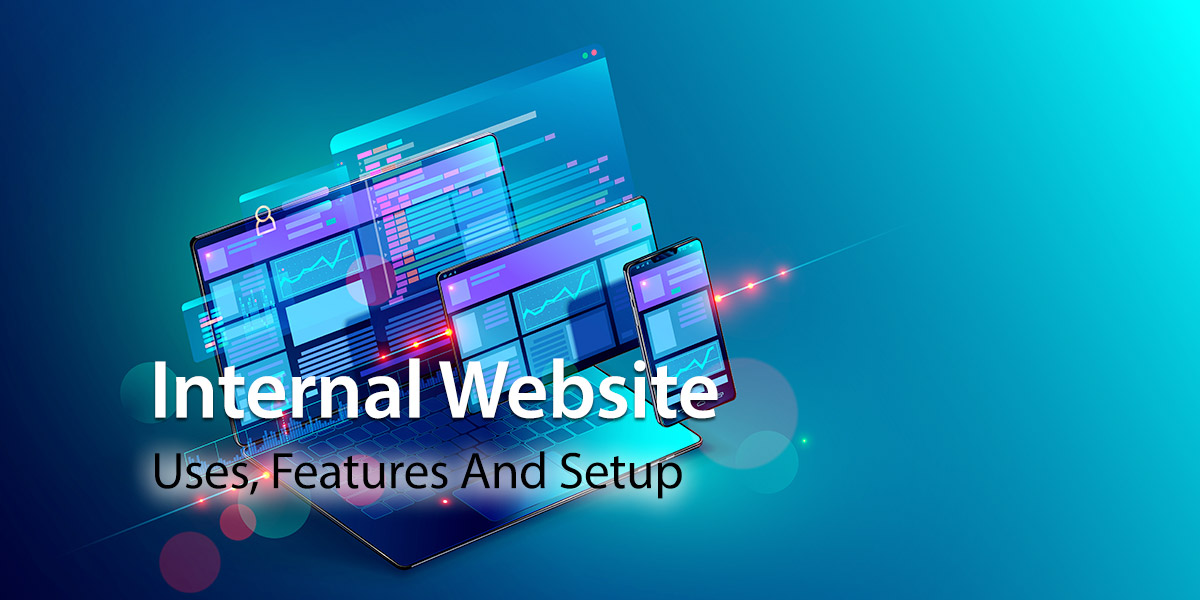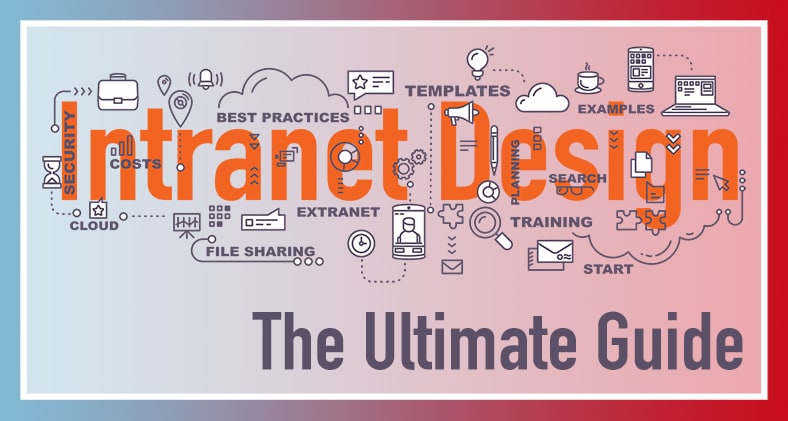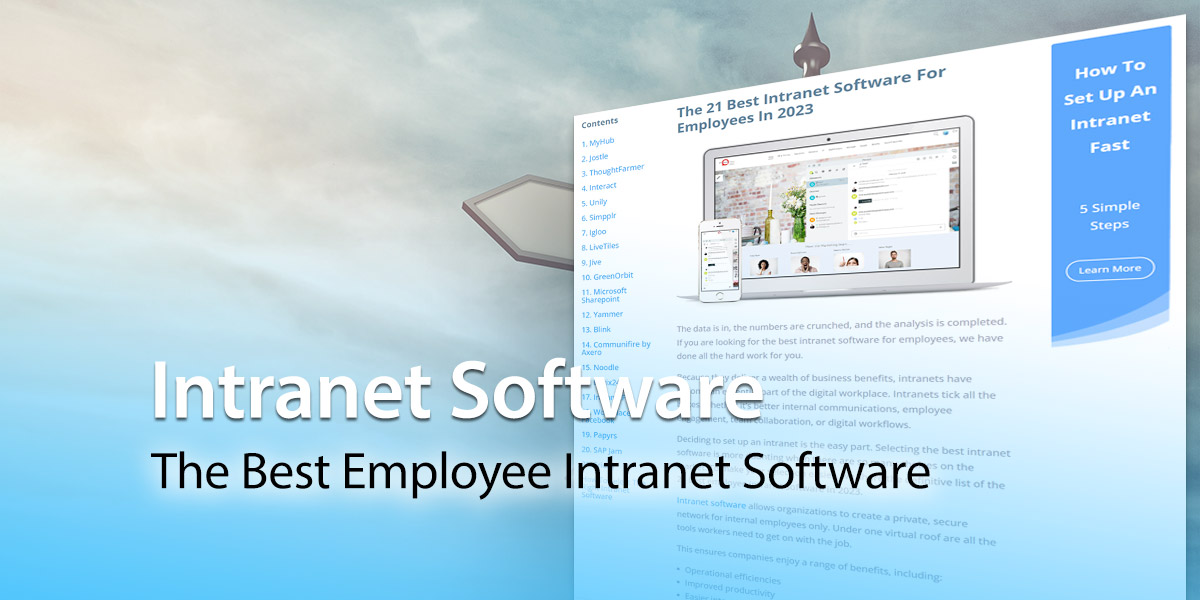Many companies spend top dollar on trend-setting customer-facing websites with all the bells and whistles. However, often it’s a different story with their internal versions. If there is one, it’s usually cluttered with outdated content, making it impossible to navigate. And when it comes to engaging users, the site falls short. This is a huge organizational own goal. As a tool for managing company information, communication, and collaboration, the internal website, or intranet, is mission-critical. This post takes you through everything you need to know, from uses and essential features to setup and ongoing management.
What Is An Internal Website?
It’s a private network only accessible to your employees. And just like internet sites, your people use the platform to find out about news, products, services, and coworkers. Your internal website has all the clicks, apps, tools, and data staff need daily.
How Do Organizations Use An Internal Website?
So, what’s the big deal – what difference will it make to my business? That’s a critical question. And the bottom line is that there are many benefits delivering more efficient and effective operations across the board. Here we showcase just a few headlines.
Information Management
Information is the driving force behind every business. And internal websites make it easier for staff to manage and share that information. Shared folders, files, and cloud storage solutions have their limitations. By contrast, your site acts like a central library for all corporate data. Your people can easily share files and data both internally and externally.
Moreover, an advanced search function and intuitive site navigation support workers in locating the latest data swiftly. An internal website means you could do away with secure file transfer software and shared folders forever. Organized in a way that makes sense to your business, the site is accessible anytime and from any location.
Internal Communications
Employees log in to the site every day. So, it’s the perfect corporate communication tool. Company or team news feeds, blogs, and newsletters keep everyone in the loop with consistent and timely messages. Allow workers to comment and offer feedback, and these tools become interactive.
Today’s workplaces are a dynamic mix of remote, hybrid, and deskless workers. So, this ease of communication and ability to engage in two-way conversations with employees is a must.
Collaboration and Joint Working
Companies that encourage cross-team collaboration are agile, innovative, and creative. More is achieved when teams work together to reach solutions.
An internal website breaks down barriers and powers up collaboration. Workers share information securely in private project or team forums. And they collaborate on documents in real time with an embedded Google Workspace or Microsoft 365 app. You can restrict access to the forum through a series of site permissions. Rather than sifting through long and complicated email threads for the latest drafts, team members can simultaneously edit and update documents online via the internal website.
Automated Business Processes
Internal websites deliver more efficient and effective working with automated business processes. Form filling of one kind or another is a fact of life for every organization. From sales reporting and budget monitoring to ordering stationery or booking vacation leave, all companies have processes ripe for automation.
Now, these everyday tasks are completed online using the integral forms builder, Google Workspace, or Microsoft 365. The software even automatically routes forms to managers for approval and action. Supervisors have better oversight of processes, and the potential for errors creeping in or paperwork going astray is significantly reduced.
Employee Engagement
It makes sense that employees who feel engaged and emotionally connected at work deliver more than their disengaged counterparts. Research from Gallup confirms that employee engagement generates improved productivity by as much as 18 percent.
Furthermore, engaged employees tend to have a longer tenure with an employer and are less likely to be off sick.
An internal website can support a corporate program of employee engagement. Improved internal communications is a crucial driver of employee engagement, and intranets contribute as follows:
- Employee appreciation schemes for reward and recognition, which promote a sense of value and gratitude
- Polls and surveys to canvass the workforce’s views on various issues
- Corporate calendars to keep employees informed on company events and deadlines
- Online training and development opportunities to upskill the workforce and promote a learning culture.
What Features Are Essential On An Internal Website?
Now that we have established the benefits, let’s look at the essential features. An internal website must deliver on the objectives we identified above. To this end, best-of-breed versions share the following features:
Easy To Setup
A site setup that’s straightforward to follow and quick to implement will see you enjoying the benefits all the sooner. This should be a top priority.
Simple To Manage
And having set up your internal website, it should be simple to manage on an ongoing basis. Managing users and content needs to be uncomplicated.
Easy To Use
Successful sites are also simple for staff to use. This involves having a good user interface, visual appeal, engaging design, intuitive site navigation, and an advanced search engine. It should also deliver the tools workers need to get the job done.
Quick To Deploy
Who has the time for extensive testing and piloting? An internal website that’s already been tried and tested by other users has a distinct advantage in the selection process.
Mobile Access
Mobile-optimized sites are a must-have, with more employees working remotely or in non-desk roles. Your people will be connected and productive regardless of location or time differences.
Cost-effectiveness
Budgets always play a part. Your intranet should be cost-effective and deliver a great return on investment.
How To Create An Internal Website
So, we’ve convinced you of the benefits and have helped you identify the essential features. But how do you get started? Well, there are three basic options:
1. Do-it-yourself
This option allows you to design your site from scratch, hosted on the company server. The advantage of this option is that you end up with a bespoke platform that syncs with your business needs.
On the downside, this option is both resource and time intensive. You will need a great deal of technical know-how. Plus, the software has to be extensively trialed and piloted. The costs soon add up, which means it also fails on the cost-effectiveness test.
2. Off-the-shelf
This option involves downloading readily available software and using it to create your intranet. Popular choices include WordPress, SharePoint, and Drupal. Often these choices are free to download, making them appealing to cost-conscious organizations.
Despite the pluses, there are some disadvantages you need to know about. A certain amount of technical know-how is still a must. And without an internal IT resource, navigating the software can be challenging for novices. Furthermore, these options have not been created for the specific purpose of developing an internal website. WordPress, for example, although capable of creating an in-house site, is more of a blogging tool.
Many organizations have also discovered that the free core offering is quite limited. Getting the functionality they want requires add-ons and plug-ins with a hefty price tag.
And there’s still the issue of hosting to resolve. If you already have a company server, hosting the software locally may be possible. And if you don’t have a server, that’s an extra expense you need to consider.
3. Cloud Intranet Software
This option allows you to create an in-house site using customizable pre-built intranet templates. A specialist intranet provider then hosts the platform in the cloud. Cloud intranet software ticks a number of the essential features we identified earlier.
Easy To Setup
A straightforward setup wizard means you don’t need a college computing degree to get off the ground. Plus, drag-and-drop editing makes it easy for anyone to create pages. And the more content that’s shared, the more valuable your site will be. Use drag and drop to add images, videos, polls, or widgets for a rich, engaging UX.
What’s more, the templates are fully customizable. Select from the range of powerful modules and tools. Then, add your stamp with colors, fonts, graphics, logos, and branding for a unique solution.
Simple To Manage
Whether it’s content or users, cloud intranets come with a set of intuitive administration tools that simplify ongoing management. Add, enable, disable and delete users using bulk management tools. And grant or deny access to content so that it’s restricted to only those that need to know.
Similarly, creating, editing, and publishing content is a simple process. A drag-and-drop page builder wizard means you can easily create new pages or sub-pages and add text, images, or graphics. Keeping your content updated and fresh is a breeze with a cloud intranet.
Easy To Use
Cloud intranet templates are thoughtfully designed by experts and reflect the latest design trends and good practices. Your internal website design will meet the highest standards in user experience and engagement.
Moreover, intranet templates have a familiar file explorer interface that makes users feel comfortable. Navigating their way around the site is easy. Plus, an advanced search function ensures your people quickly find what they need.
The wide selection of tools and modules supports employees in completing their daily work more efficiently and effectively.
Quick To Deploy
The cloud intranet’s templates are tried and tested by the provider so that you can have confidence in the tools and functionality. There’s no need for extensive testing or piloting. The simple five-step site builder process means your internal website could be live within hours. And because the software is so easy to use and manage, you won’t need an extensive staff training program.
Mobile Optimization
A mobile-optimized internal website means remote workers and deskless staff can access all the same functionality as head office. Intranet templates are optimized for smaller screens, including smartphones and tablets. Achieving the same precision with a touchscreen is tricky. And so, mobile designs are clutter-free and finger-sensitive, ensuring employees have all the necessary tools.
Cloud Intranets Come With Value-Added Extras
Your cloud intranet also comes with the following crucial advantages over DIY options:
Cost-effectiveness
Cost certainty is vital for any business. All the great features we have identified here are available for a fixed monthly fee. This covers unlimited users as well as unlimited data storage. Cloud intranets offer value for money and a great return on investment.
Single-sign-on
With just one login, your people can access all your enterprise apps and tools. No more switching between screens with multiple logins and passwords. Your integrated internal website streamlines access and powers up productivity.
Security Assured
Whether it’s safeguarding against internal or external security threats, DIYers have a major headache. Keeping on top of cybersecurity is their responsibility alone. However, those with cloud platforms have it easy. Providers are responsible for all security. And that means the latest SSL encryption, SOC 2 compliance, secure connections, and internal permissions and restrictions.
Automatic Updates And Backups
Not only do cloud providers take care of hosting, but they are also responsible for software maintenance and backups. You don’t need to worry about installing, configuring, and maintaining complicated software. Even better, you get access to new tools, features, and functionality as providers constantly innovate the software.
On-demand Customer Support
There may be online communities of interest for WordPress or SharePoint users, but there’s no substitute for on-demand support. Cloud providers are there to help when you need it most, whether it’s design, prototype, launch, or post-implementation.
Tips On What To Include On Your Intranet’s Homepage
The homepage is the launchpad to your entire site. Get it right, and users will jump on board from the get-go. However, get it wrong, and your internet flops before it’s even started.
The design of your homepage will depend on the type of organization you are and your objectives. For example, the homepage for a law firm’s internal website is bound to look different from a trend-setting tech startup.
Although there will be plenty of differences, there are some overarching common principles. Check out our 19 intranet examples to guide and inspire you. Here’s a handy summary of what you need to know.
People Focus
Best-of-breed intranets have people as their primary focus. After all, it’s people that collaborate, not content. Build the platform around your workers and their needs rather than policies and procedures. Usually, that involves quick links to popular content like news, teams, discussions, events, and tasks. And have a prominent search engine to support staff in finding what they need.
Three-stage Approach
This is a helpful tool for deciding what needs to go on the homepage. And the best place to start is with the basics. Work out what tools, apps, features, and links your people use daily. It’s the everyday basics that need to be center stage. The next priority is context. This covers the company, departmental and industry knowledge, and information staff use to inform their work. Finally, is the people stuff. Think of staff news, shoutouts, events, activity walls, employee profiles, and recognition programs. The three-stage approach will see you create a homepage that engages, informs, and connects the workforce.
Make It Visual
An eye-catching vibrant homepage packs a punch. Graphics, videos, and images can convey more information than words alone. So, use them to bring vibrancy and maximum impact to the homepage.
Less Is More
Tempting though it is to pack in as much as possible, the minimalist approach works best. More content can be overwhelming and confusing for users. Instead, use descriptive section headings, navigation links, and accordions to invite the user to dig deeper. And select a neutral color palette that’s easy on the eye. However, add a pop of bright color here and there for interest and variety.
Present Content In Bite-sized Chunks
Breaking up content in a modular page grid separated by white space supports the uncluttered approach you want to achieve. Keeping it simple will reap dividends in user engagement by delivering a first-rate UX.
Internal Website: The MyHub Solution
Are you interested in discovering more about the potential of a cloud intranet to deliver your internal website? Then get in touch with us here at MyHub. We have over 20 years of experience creating beautifully designed internal websites that your people will want to use.
We will take you through our super easy intranet in a free demo. We also offer a 14-day no-obligation trial so that you can test out our software before signing on the dotted line.
And if time and resources are an issue, MyHub’s design service could be the solution you need. Our expert team works with you to develop a customized, fully functioning intranet in 40 days or less. Guaranteed.











0 Comments